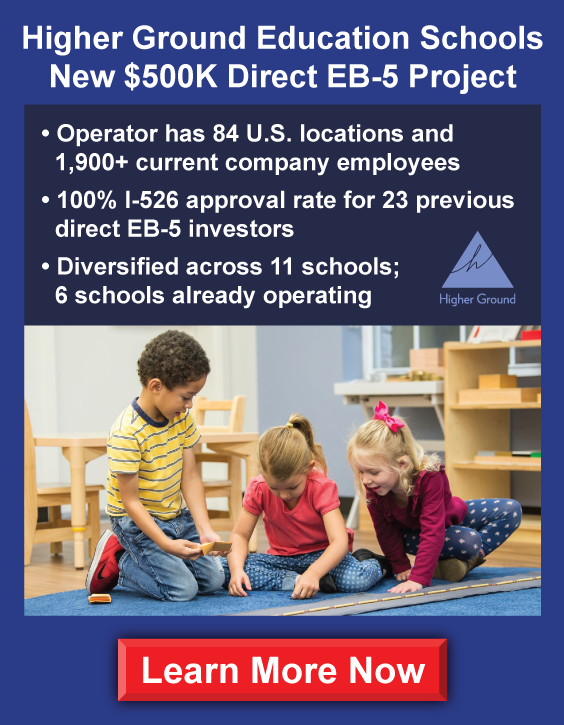U.S. Job Creation at No Cost to the Taxpayer: An Idea We Can All Agree on
Even with the partisan wrangling and increasingly heated presidential campaign rhetoric, there are general principles Republicans and Democrats coalesce around: increased investment in the United States and more U.S. jobs without the burden on the taxpayer. As members of Congress adjourn for their August recess, a consensus is building to reauthorize a program that supports such job creation in our still recovering economy.
After years of being underutilized, the federal immigrant investor visa program -- known as the EB-5 Program (the "Program") -- has finally come into its own, annually attracting billions of dollars in foreign direct investment (FDI) that creates jobs and spurs economic development at no cost to taxpayers. For this to continue Congress needs to reauthorize the program before the end of September, otherwise it will expire.
The EB-5 Program, which has enjoyed strong bipartisan support since its inception, allows foreign nationals who invest $500,000 or $1,000,000 in approved U.S. businesses to become eligible for permanent residency if their investment creates at least 10 American jobs. From FY2010 to FY2013, the program has contributed $9.6 billion to GDP and supported an average of 29,300 jobs each year.
The growth in the program has been exponential in the last few years and continues at an impressive clip. According to Invest in the USA's (IIUSA) analysis, $1.815 billion in investment was generated in the first two quarters of FY2015 alone -- a $400 million increase compared to the first two quarters of FY2014 and a $1.1 billion increase over the same period in FY2013. There are over 13,000 immigrant petitions waiting on approval by the U.S. Citizenship and Immigration Services (USCIS), representing more than $6.5 billion in potential incoming capital.
With this much investment in the pipeline, Congress should recognize that EB-5 is an important financing tool for job-creating projects that must continue. As discussions continue on Capitol Hill about reauthorizing and reforming the program, it is critical that both chambers of Congress work together to develop a consensus legislation that quickly and thoughtfully reauthorizes the program before the September 30 sunset date.
The recent rapid growth of the program shows just how important EB-5 has become to U.S. capital markets that have changed significantly since the Great Recession. Today, capital-intensive projects require much more diversification of financing on the front-end of the development process. Filling this financing niche, EB-5 has evolved from an underemployed program to a lifeline for commercial real estate projects post-recession to a funding mechanism for a range of projects from hospitals and highways to energy to assisted living.
As an example, up until a few weeks ago, when residents of Green Valley, Arizona and nearby communities needed urgent medical care, they had to travel 30 miles to hospitals in Tucson. With approximately 10 patients per day transported by ambulance from Green Valley to the Tucson facilities, the region was designated a "medically-underserved area." Through EB-5, $56 million was invested in the development of a new, state-of-the-art 50-bed hospital that has now opened its doors to the community.
And, thanks to EB-5, an ethanol plant has started operating in Spiritwood, North Dakota, using local corn and steam power to produce an estimated 65 million gallons of ethanol per year. Capital from EB-5 investors provided more than half the funds needed to build the plant, making it financially viable for the rural region. By creating jobs and clean energy, this EB-5 project is good for rural workers, good for the environment, and good for the American economy.
The program's value is not lost on local leaders who increasingly see EB-5 as a way to attract vital capital for economic development projects. The U.S. Conference of Mayors and the National Association of Counties have both passed resolutions supporting reauthorization of EB-5, and a letter urging Congress to continue the program currently has 680 signatories.
This is not to say that some program reforms are not needed. As with any complex federal policy, there will be growing pains and issues that need to be addressed to ensure that implementation and oversight are appropriate. But in that reform and improvement process, it is important not to inadvertently undermine the program's ability to create jobs and spur economic development.
The potential of EB-5 is finally being realized with billions of dollars and a diverse range of projects coming on-line. It's up to Congress to find a reauthorization package that enhances and grows EB-5 as a secure and effective engine for economic growth and job creation in the U.S. for years to come.
Mentions
States
- New York
Videos





Subscribe for News
Site Digest
Join Professionals on EB5Projects.com →
Securities Disclaimer
This website is for informational purposes only and does not constitute an offer or solicitation to sell shares or securities. Any such offer or solicitation will be made only by means of an investment's confidential Offering Memorandum and in accordance with the terms of all applicable securities and other laws. This website does not constitute or form part of, and should not be construed as, any offer for sale or subscription of, or any invitation to offer to buy or subscribe for, any securities, nor should it or any part of it form the basis of, or be relied on in any connection with, any contract or commitment whatsoever. EB5Projects.com LLC and its affiliates expressly disclaim any and all responsibility for any direct or consequential loss or damage of any kind whatsoever arising directly or indirectly from: (i) reliance on any information contained in the website, (ii) any error, omission or inaccuracy in any such information or (iii) any action resulting therefrom.



